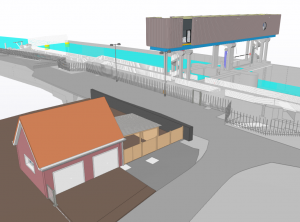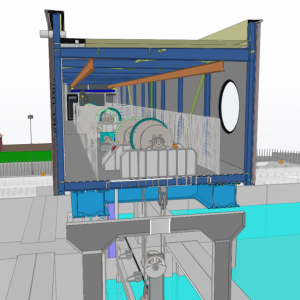Renovatie van de stuw en de bouw van een vispassage

| Categorie | Infrastructurele projecten |
|---|---|
| Jaar | 2021 |
| Land | Benelux |
| Organisatie | Tractebel Engie |
| Projectpartners | Tractebel Engie - URBAN |
| Auteur | Leen Meul |
| Cliënt | De Vlaamse Waterweg |
| Plaats van constructie | Sint-Baafs-Vijve (B) |
| Tags |
De werken in Sint-Baafs-Vijve maken deel uit van het binnenvaartproject Seine Schelde Vlaanderen, dat steun geniet van de Europese Unie. Het project wil van de binnenvaart een sterker alternatief maken voor het goederenvervoer op de weg. Omdat De Vlaamse Waterweg als waterwegbeheerder ook het leven op én langs het water belangrijk vinden, investeren ze eveneens in rivierherstel en duurzame waterbeheersing.
De opdracht voor De Vlaamse Waterweg is tweeledig. Aan de stuw in Sint-Baafs-Vijve, op de oude Leie-arm, bouwt De Vlaamse Waterweg een nieuwe vispassage. De stuw zelf wordt ook gerenoveerd.
Renovatie stuw
Een stuw regelt de stand van het water voor de waterbeheersing. Stuwen voeren het water af of aan en vermijden wateroverlast of droogte. Zo beschermt De Vlaamse Waterweg enerzijds de omgeving langs het water en garanderen ze anderzijds de bedrijfszekerheid van de binnenvaart. In droge periodes zullen de stuwen dus vaker dicht zijn om water op te houden. In periodes met veel regen zijn de stuwen geopend om het water af te voeren.
De huidige stuw in Sint-Baafs-Vijve is verouderd en wordt gerenoveerd. Zo wordt de elektromechanische uitrusting van de stuw helemaal vernieuwd, maar krijgt ze ook een volledige opfrisbeurt. Het portiek van de stuw wordt compleet vernieuwd en krijgt een hedendaagse look. De gevelbekleding van het nieuwe portiek sluit aan bij de gevelbekleding van het nieuwe dienstgebouw, waardoor alle bouwwerken omgevormd worden tot een mooi geheel.
Bouw nieuwe vispassage
Vissen verplaatsen zich voortdurend doorheen een waterloop op zoek naar voedsel, paai- en broedplaatsen, overwinteringsgebieden of nieuwe leefgebieden. Stuwen zijn dan ook een grote hindernis voor vissen. Ze vormen een fysiek obstakel en zorgen voor een te hoge stroomsnelheid van het water. Vissen kunnen er namelijk niet zomaar voorbij zwemmen. Parallel met de renovatie van de stuw wordt in de oude, klasse I-sluis (vlak naast de stuw) een nieuwe vispassage gebouwd. De oude sluis zal dus niet langer gebruikt worden als sluis, want hier wordt een ‘enkel vertical slot’-constructie gebouwd waarbij de vissen door de passage zigzaggen naar de andere kant. Daarnaast wordt er eveneens met een toegevoegd debiet gewerkt. Dit wil zeggen dat er “extra” water via een klein, parallel kanaal in het laatste deel van de vispassage wordt ingebracht om zo de lokstroom voor de vissen te versterken. Tegelijkertijd zorgt dit toegevoegd debiet ervoor dat de vispassage kan blijven functioneren in periodes van droogte.
Ter bescherming van de beide structuren wordt helemaal opwaarts een aanvaarbeveiliging geconstrueerd.
Omwille van een strakke planning dienen beide werken parallel naast elkaar te worden uitgevoerd. De rechteroever ter hoogte van de oude stuw en sluis wordt ingericht als werfzone en is niet meer toegankelijk voor het verkeer. Voor de fietsers -en voetgangers zal een omlegging rond de werfzone worden voorzien zodat zij tijdens de werken de jachthaven, opwaarts gelegen van de stuw/sluis, kunnen bereiken. De fasering van de werken is heel belangrijk.
Om de bovenvermelde uitdagingen te tackelen dienden verschillende disciplines binnen Tractebel intens samen te werken en informatie uit te wisselen. Een uitgelezen kans om de aspecten bestaande toestand, nutsvoorzieningen, architectuur, staalstructuur, betonnen structuur, elektromechanica, veiligheid, onderhoud, en duurzaamheid maximaal op elkaar af te stemmen.
Samenwerkingsproces
Tijdens het ontwerpproces was het erg belangrijk om een manier te vinden om de informatie efficiënt uit te wisselen, omdat iedereen binnen zijn domein werkt in het daartoe meest geschikte ontwerppakket. Het IFC bestandsformaat bleek hierbij de sleutel.
The works in Sint-Baafs-Vijve are part of the inland waterway project Seine Schelde Vlaanderen that is supported by the European Union. The project wants to make inland navigation a stronger alternative for goods transport by road. Because De Vlaamse Waterweg, as waterway manager, also considers life on and along the water important, they also invest in river restoration and sustainable water management.
The task for De Vlaamse Waterweg is twofold. At the weir in Sint-Baafs-Vijve, on the old branch of the Leie, De Vlaamse Waterweg is building a new fish passage. The weir itself is also being renovated.
Weir renovation
A weir regulates the water level for water control. Dams discharge or supply water and prevent flooding or drought. On the one hand they protect the environment along the waterway and on the other hand they guarantee the reliability of inland navigation. In dry periods the weirs will therefore be closed more often to retain water. In periods of heavy rainfall, the weirs are opened to drain the water.
The current weir in Sint-Baafs-Vijve is outdated and will be renovated. The electromechanical equipment of the weir will be completely renewed, but it will also be given a facelift. The portico of the weir will be completely renovated and given a contemporary look. The cladding of the new portico will match the cladding of the new service building, thus transforming all the structures into an attractive whole.
Construction of a new fish passage
Fish are constantly moving through a waterway in search of food, spawning and breeding grounds, wintering areas or new habitats. Weirs are therefore a major obstacle for fish. They form a physical obstacle and cause the water to flow too fast. Fish cannot simply swim past them. Parallel to the renovation of the weir, a new fish passage will be built in the old, class I lock (right next to the weir). The old lock will therefore no longer be used as a lock, as a ‘single vertical slot’ construction will be built here, allowing the fish to zigzag through the passage to the other side. In addition, an increased flow will also be used. This means that ‘extra’ water is introduced into the last part of the fish passage via a small, parallel channel in order to increase the lure flow for the fish. At the same time, this additional flow ensures that the fish passage can continue to function in periods of drought.
To protect both structures, a safety barrier will be constructed all the way upstream.
Due to tight planning, both works must be carried out in parallel. The right bank at the old weir and lock will be set up as a work zone and is no longer accessible to traffic. Cyclists and pedestrians will be able to make a detour around the construction site so that they can reach the marina, located upstream from the weir/lock, during the works. The phasing of the works is very important.
In order to tackle the above challenges, different disciplines within Tractebel had to cooperate intensively and exchange information. An excellent opportunity to align the aspects of the existing situation, utilities, architecture, steel structure, concrete structure, electro mechanics, safety, maintenance and sustainability.
Collaboration process
During the design process, it was very important to find a way to exchange information efficiently, because everyone works within his domain in the most appropriate design package. The IFC file format proved to be the key to this.




